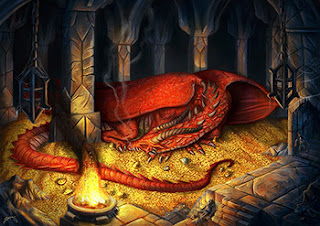 |
| This is neat and all, but it loses impact after a while |
"Chaoskampf" refers to a common mythological theme where heroes fight chaos, which is commonly personified as a dragon or serpent. "Draconite" is a magical gemstone found in the heads of dragons. A person who eats part of a dragon's heart may learn the language of the birds, as in the myth of Fafnir, which doesn't require you to constantly cast speak with animals.
In my campaign setting, I decided to make dragons into personifications of the magical underpinnings of the world. They might arise spontaneously, but from a narrative perspective it would be more interesting if they have some discernible reason for guarding a treasure or bedeviling a kingdom beyond base urges. For example, a dragon guarding a treasure used to be a man who was cursed into that form, a dragon is punishing the king until he admits to some wrongdoing, etc.
Useful game books include AEG's Dragons, Legends & Lairs: Draconic Lore, Slayer's Guide to Dragons, The Book of Dragons, and Relics & Rituals: Excalibur.
Here is a list of miscellaneous and game-related links to get some ideas about imagining dragons:
- http://www.blackdrago.com/
- http://tvtropes.org/pmwiki/pmwiki.php/OurDragonsAreDifferent/Mythology
- https://www.reddit.com/r/DnD/comments/2nbc3s/make_dragons_scary_again/
- http://mistholme.com/dictionary/dragon/
- https://web.archive.org/web/20081219222303/http://www.eaudrey.com:80/myth/serpents+dragons.htm
- http://oldguardgamingaccoutrements.blogspot.com/2009/10/unexpurgated-dragon-generator.html
- https://rpgcharacters.wordpress.com/2011/03/15/reskinning-dragons/
- https://exemplore.com/misc/Shape-Shifting-Dragons-of-Folklore
- http://lonelygm.blogspot.com/2013/02/changing-gamers-assumptions-about.html
- https://www.reddit.com/r/DnDBehindTheScreen/comments/5k7g67/random_dragon_generator/
- http://fantasy-faction.com/2013/dragons-type-sub-type-and-racial-appearance
- http://screencrush.com/scienfitic-summary-movie-dragons/
- https://lizardshuffle.tumblr.com/tagged/hoards
No comments:
Post a Comment